
The Tennessee State Capitol in Nashville has been the site of much of the State's history.
Tennessee is an American state and a constituent part of the United States of America. It was admitted to the Union on June 1, 1796.
Ancient history[]
The area now known as Tennessee was first settled by Paleo-Indians nearly 11,000 years ago. The names of the cultural groups that inhabited the area between first settlement and the time of European contact are unknown, but several distinct cultural phases have been named by archaeologists, including Archaic, Woodland, and Mississippian whose chiefdoms were the cultural predecessors of the Muscogee people who inhabited the Tennessee River Valley prior to Cherokee migration into the river's headwaters.
European exploration and settlement[]
Discovery and interaction with native peoples[]
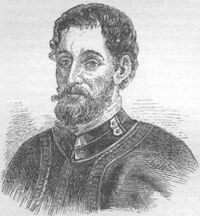
Spanish conquistador Hernando de Soto was the first European explorer to visit Tennessee.
When Spanish explorers first visited the area, led by Hernando de Soto in 1539–43, it was inhabited by tribes of Muscogee and Yuchi people.
Possibly because of European diseases devastating the Native tribes, which would have left a population vacuum, and also from expanding European settlement in the north, the Cherokee moved south from the area now called Virginia. As European colonists spread into the area, the native populations were forcibly displaced to the south and west, including all Muscogee and Yuchi peoples, including the Chickasaw and Choctaw.
From 1838 to 1839, the US government forced Cherokees to leave the eastern United States. Nearly 17,000 Cherokees were forced to march from Eastern Tennessee to Indian Territory west of Arkansas. This came to be known as the Trail of Tears, as an estimated 4,000 Cherokees died along the way.1
Government under North Carolina[]
In the days before statehood, Tennesseans struggled to gain a political voice and suffered for lack of the protection afforded by organized government. Six counties—Washington, Sullivan and Greene in East Tennessee and Davidson, Sumner, and Tennessee in Middle Tennessee—had been formed as western counties of North Carolina between 1777 and 1788.
After the American Revolution, however, North Carolina did not want the trouble and expense of maintaining such distant settlements, embroiled as they were with hostile tribesmen and needing roads, forts and open waterways. Nor could the far-flung settlers look to the national government, for under the weak, loosely constituted Articles of Confederation, it was a government in name only.
State of Franklin[]
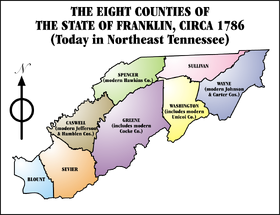
The westerners' two main demands—protection from the Indians and the right to navigate the Mississippi River—went mainly unheeded during the 1780s. North Carolina’s insensitivity led frustrated East Tennesseans in 1784 to form the breakaway State of Franklin.
John Sevier was named governor, and the fledgling state began operating as an independent, though unrecognized, government. At the same time, leaders of the Cumberland settlements made overtures for an alliance with Spain, which controlled the lower Mississippi River and was held responsible for inciting the Indian raids. In drawing up the Watauga and Cumberland Compacts, early Tennesseans had already exercised some of the rights of self-government and were prepared to take political matters into their own hands.
Such stirrings of independence caught the attention of North Carolina, which quietly began to reassert control over its western counties. These policies and internal divisions among East Tennesseans doomed the short-lived State of Franklin, which passed out of existence in 1788.
Southwest Territory[]
When North Carolina finally ratified the Constitution of the United States in 1789, it also ceded its western lands, the Tennessee country, to the Federal government. North Carolina had used these lands as a means of rewarding its Revolutionary soldiers. In the Cession Act of 1789, it reserved the right to satisfy further land claims in Tennessee.
Congress designated the area as the "Territory of the United States, South of the River Ohio", more commonly known as the Southwest Territory. The territory was divided into three districts—two for East Tennessee and one for the Mero District on the Cumberland—each with its own courts, militia and officeholders.
President George Washington appointed William Blount as territorial governor. He was a prominent North Carolina politician with extensive holdings in western lands.
Admission to the Union[]
In 1795, a territorial census revealed a sufficient population for statehood. A referendum showed a three-to-one majority in favor of joining the Union. Governor Blount called for a constitutional convention to meet in Knoxville, where delegates from all the counties drew up a model state constitution and democratic bill of rights.
The voters chose Sevier as governor. The newly elected legislature voted for Blount and William Cocke as Senators, and Andrew Jackson as Representative.
Tennessee leaders thereby converted the territory into a new state, with organized government and constitution, before applying to Congress for admission. Since the Southwest Territory was the first Federal territory to present itself for admission to the Union, there was some uncertainty about how to proceed, and Congress was divided on the issue.
Nonetheless, in a close vote on June 1, 1796, Congress approved the admission of Tennessee as the sixteenth state of the Union. They drew its borders by extending the northern and southern borders of North Carolina, with a few deviations, to the Mississippi River, Tennessee's western boundary.
Antebellum Years[]
In the early years of settlement, planters brought slaves with them from Kentucky and Virginia. Enslaved African Americans were first concentrated in Middle Tennessee, where planters developed mixed crops and bred high quality horses and cattle, as they did in the Inner Bluegrass region of Kentucky. East Tennessee had more subsistence farmers and few slaveholders.
During the early years of state formation, there was support for emancipation of slaves, founded in part on fears by whites of competition with slave labor (who could be hired out) in the middle and eastern parts of the state. At the constitutional convention of 1796, free Negroes were given the right to vote if they met residency and property requirements. Efforts to abolish slavery were defeated at this convention and again at the convention of 1834. The convention of 1834 also marked the state's retraction of suffrage for most free African Americans. By then slaveholding had expanded markedly in the state, especially in the Mississippi Delta where cotton planters held large groups of enslaved African Americans, often numbering in the hundreds.
By 1830 the number of African Americans had increased from less than 4,000 at the beginning of the century, to 146,158. This was chiefly related to development of large plantations and transportation of numerous slaves to the Cotton Belt in West Tennessee, in the area of the Mississippi Delta. African American labor created the cotton plantations that generated so much wealth for the planters. By 1860 the enslaved population had nearly doubled to 283,019, with only 7,300 free Negroes in the state.[1] While most of the slaves were concentrated in West Tennessee, planters in Middle Tennessee also used enslaved African Americans for labor but had smaller operations and held fewer slaves. According to the 1860 census, enslaved African Americans comprised about 25% of the state's population of 1.1 million before the Civil War.
Civil War[]
The American Civil War, to a large extent, was fought in cities and farms of Tennessee—only Virginia had more battles.
Secession[]
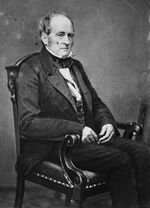
John Bell
Most Tennesseans initially showed little enthusiasm for breaking away from a nation whose struggles it had shared for so long. There were small exceptions such as Franklin County, which borders Alabama in southern Middle Tennessee; Franklin County formally threatened to secede from Tennessee and join Alabama if Tennessee did not leave the Union. Franklin County withdrew this threat when Tennessee did eventually secede. In 1860, Tennesseans had voted by a slim margin for the Constitutional Unionist John Bell, a native son and moderate who continued to search for a way out of the crisis.
In February 1861, fifty-four percent of the state’s voters voted against sending delegates to a secession convention. With the attack on Fort Sumter in April, however, followed by President Abraham Lincoln’s call for 75,000 volunteers to coerce the seceded states back into line, public sentiment turned dramatically against the Union.
Thus historian Daniel Crofts reports:
- Unionists of all descriptions, both those who became Confederates and those who did not, considered the proclamation calling for seventy-five thousand troops "disastrous." Having consulted personally with Lincoln in March, Congressman Horace Maynard, the unconditional Unionist and future Republican from East Tennessee, felt assured that the administration would pursue a peaceful policy. Soon after April 15, a dismayed Maynard reported that "the President's extraordinary proclamation" had unleashed "a tornado of excitement that seems likely to sweep us all away." Men who had "heretofore been cool, firm and Union loving" had become "perfectly wild" and were "aroused to a phrenzy of passion." For what purpose, they asked, could such an army be wanted "but to invade, overrun and subjugate the Southern states." The growing war spirit in the North further convinced southerners that they would have to "fight for our hearthstones and the security of home."[2]
Governor Isham Harris began military mobilization, submitted an ordinance of secession to the General Assembly, and made direct overtures to the Confederate government.
In a June 8, 1861, referendum, East Tennessee held firm against separation, while West Tennessee returned an equally heavy majority in favor. The deciding vote came in Middle Tennessee, which went from 51 percent against secession in February to 88 percent in favor in June.
Having ratified by popular vote its connection with the fledgling Confederacy, Tennessee became the last state to withdraw from the Union.
People in East Tennessee were firmly against Tennessee's move to leave the Union; as were many in other parts of the Union, particularly in historically Whig portions of West Tennessee.[3] Tennesseans representing twenty-six East Tennessee counties met twice in Greenville and Knoxville and agreed to secede from Tennessee. They petitioned the state legislature in Nashville, which denied their request to secede and sent Confederate troops under Felix Zollicofer to occupy East Tennessee and prevent secession. Many East Tenneseans engaged in guerrilla warfare against state authorities by burning bridges, cutting telegraph wires, and spying.[4]
Battles[]

The Third Battle of Chattanooga was fought November 23-25, 1863.
Many battles were fought in the state—most of them Union victories. Ulysses S. Grant and the United States Navy captured control of the Cumberland and Tennessee Rivers in February 1862 and held off the Confederate counterattack at Shiloh in April of the same year.
Capture of Memphis and Nashville gave the Union control of the Western and Middle sections. Control was confirmed at the Battle of Stones River at Murfreesboro in early January 1863.
After Nashville was captured (the first Confederate state capital to fall) Andrew Johnson, an East Tennessean from Greeneville, was appointed military governor of the state by Lincoln. The military government abolished slavery in the state and Union troops occupied much of the state through the end of the war. The long occupation depleted resources and contributed to a breakdown in the social order in many areas.
The Confederates continued to hold East Tennessee despite the strength of Unionist sentiment there, with the exception of pro-Confederate Sullivan County.
The Confederates besieged Chattanooga in early fall 1863 but were driven off by Grant in November. Many of the Confederate defeats can be attributed to the poor strategic vision of General Braxton Bragg, who led the Army of Tennessee from Shiloh to Confederate defeat at Chattanooga.
The last major battles came when the Confederates invaded in November 1864 and were checked at Franklin, then totally destroyed by George Thomas at Nashville in December.
Reconstruction[]
After the war, Tennessee adopted a constitutional amendment forbidding property in men February 22, 1865; ratified the Fourteenth Amendment to the United States Constitution on July 18, 1866; and was the first state readmitted to the Union on July 24, 1866.
Because it ratified the Fourteenth Amendment, Tennessee was the only state that seceded from the Union that did not have a military governor during Reconstruction.
As in most Southern states, many white citizens had not accepted the results of the Civil War. Reactions have to be seen against an environment of wholesale shifts in power, and no group gives up power willingly. Many whites had not changed their thinking about allowing freedmen full citizenship and the exercise of suffrage. They had deprived blacks of education and come to believe the African Americans could not learn. Tensions ranged from fear of competition with blacks for jobs in East Tennessee, to concerns by planters in Middle and West Tennessee about being able to get enough labor for their farms. Often they did not think African Americans would work without coercion.
On January 4, 1868, the Nashville Republican Banner published an editorial calling for a revolutionary movement of white Southerners to unseat the one-party state rule of the Republican Party and restore the racial subjugation of the region's blacks. "In this State," the paper argued, "reconstruction has perfected itself and done its worst. It has organized a government which is as complete a closed corporation as may be found; it has placed the black man over the white as the agent and prime-move of domination; it has constructed a system of machinery by which all free guarantees, privileges and opportunities are removed from the people.... The impossibility of casting a free vote in Tennessee short of a revolutionary movement ... is an undoubted fact." [cited in Harcourt 2005]
In fact there were only two or three African Americans in the Tennessee legislature during Reconstruction. Others served as state and city officers. Even with increased participation on the Nashville City Council, African Americans held only one-third of the seats. Whites thus clearly continued to control the state. In his race for Congress in 1872, Andrew Johnson addressed African Americans in speaking campaigns in western counties, saying, "If fit and qualified by character and education, no one should deny you the ballot." [5] Of course if the African Americans had generally been "fit by education", they would have been more fit than many poor whites, who could not have passed educational requirements, either.
Centennial[]

A full-scale replica of Athens' Parthenon was built for the Centennial Exposition.
In 1897, the state celebrated its centennial of statehood (albeit one year late) with a great exposition in Nashville.
The Tennessee Centennial Exposition was the ultimate expression of the Gilded Age in the Upper South—a showcase of industrial technology and exotic papier-mâché versions of the world’s wonders. During its six-month run at Centennial Park, the Exposition drew nearly two million visitors to see its dazzling monuments to the South’s recovery.
Governor Robert Taylor observed, “Some of them who saw our ruined country thirty years ago will certainly appreciate the fact that we have wrought miracles.”
Alvin C. York[]
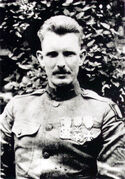
Alvin C. York
Tennessee provided the most celebrated American soldier of the First World War: Alvin C. York of Fentress County. York was a former conscientious objector who, in October 1918, subdued an entire German machine gun regiment in the Argonne Forest.
Besides receiving the Medal of Honor and assorted French decorations, York became a powerful symbol of patriotism in the press and Hollywood film.
Women's Rights[]
Tennessee became the focus of national attention during the campaign for women’s voting rights. Like the temperance movement, women’s suffrage was an issue with its roots in middle-class reform efforts of the late 1800s.
The organized movement came of age with the founding of the Tennessee Equal Suffrage Association in 1906. Despite a determined (and mostly female) opposition, Tennessee suffragists were moderate in their tactics and gained limited voting rights before the national question arose.
In 1920, Governor Albert Roberts called a special session of the General Assembly to consider ratification of the Nineteenth Amendment to the United States Constitution.
Leaders of the rival groups flooded into Nashville to lobby the General Assembly. In a close House vote, the suffrage amendment won passage when an East Tennessee legislator, Harry Burn, switched sides after receiving a telegram from his mother encouraging him to support ratification.
Tennessee thereby became the pivotal state to approve the Nineteenth Amendment.
Women immediately made their presence felt by swinging Tennessee to Warren Harding in the 1920 presidential election. It was the first time since 1868 that the state had voted for a Republican presidential candidate.
Monkey Trial[]
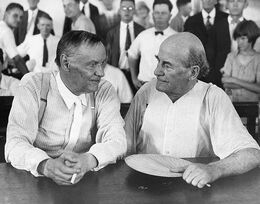
Clarence Darrow (left) and William Jennings Bryan (right) chat in court during the trial.
Further national attention came Tennessee’s way during the trial of John T. Scopes, the so-called “Scopes Monkey Trial.”
In 1925, the General Assembly, as part of a general education bill, passed a law that forbade the teaching of evolution in the public schools. Some local boosters in Dayton concocted a scheme to have Scopes, a high school biology teacher, violate the law and stand trial as a way of drawing publicity and visitors to the town.
Their plan worked all too well, as the Rhea County Courthouse was turned into a circus of national and even international media coverage. Thousands flocked to Dayton to witness the high-powered legal counsel: William Jennings Bryan for the prosecution, and Clarence Darrow for the defense, argue their case.
Tennessee was ridiculed in the northeast and West Coast press as the “Monkey State,” even as a wave of revivals defending religious fundamentalism swept the state.
The legal outcome of the trial was inconsequential: Scopes was convicted and fined $100, a penalty later rescinded by the state court of appeals. The law itself remained on the books until 1967. More important was the law’s symbolic importance. It was an expression of the anxiety felt by Tennessee’s rural people over the threat which they believed modern science posed to their traditional religious culture.
Country Music Birthplace[]

The Ryman Auditorium, the home of the Grand Ole Opry in Nashville.
Ironically, at the very time that Tennessee’s rural culture was under attack by sophisticated, urban critics, its music found a national audience.
In 1925, WSM, a powerful Nashville radio station, began broadcasting a weekly program of live music which soon was dubbed the “Grand Ole Opry.” Such music came in diverse forms: banjo-and-fiddle string bands of Appalachia, family gospel singing groups, and country vaudeville acts like that of Murfreesboro native Uncle Dave Macon.
Still the longest-running radio program in American history, the Opry used the new technology of radio to tap into a huge market for “old time” or “hillbilly” music.
Two years after the Opry’s opening, in a series of landmark sessions at Bristol, field scouts of the Victor Company recorded Jimmie Rodgers and the Carter Family to produce the first nationally popular rural records.
Tennessee thus emerged as the heartland of traditional country music—home to many of the performers as well as the place from which it was broadcast to the nation.
The Great Depression and TVA[]

The first TVA dam, Norris Dam, was completed in 1936.
The need to create work for the unemployed during the Great Depression, the desire for rural electrification, and the desire to control the annual spring floods on the Tennessee River drove the creation of the Tennessee Valley Authority, the nation's largest public utility, in 1933.
TVA had an impact on the lives of nearly all Tennesseans. The agency was created mainly through the persistence of a Nebraska Senator George Norris. Headquartered in Knoxville, it was charged with the task of planning the total development of the Tennessee River Valley. TVA sought to do this primarily by building hydroelectric dams (twenty between 1933 and 1951) and coal-fired power plants to produce electricity.
Inexpensive and abundant electrical power was the main benefit that TVA brought to Tennessee, particularly to rural areas that previously did not have electrical service. TVA brought electricity to about 60,000 farm households across the state.
By 1945, TVA was the largest electrical utility in the nation, a supplier of vast amounts of power whose presence in Tennessee attracted large industries to relocate near one of its dams or steam plants.
World War II[]
World War II brought relief to Tennessee by employing ten percent of the state’s populace (308,199 men and women) in the armed services. Most of those who remained on farms and in cities worked on war-related production, since Tennessee received war orders amounting to $1.25 billion.
Tennessee military personnel served with distinction from Pearl Harbor to the final, bloody assaults at Iwo Jima and Okinawa, and 7,000 died in combat during the war. In 1942-43, Middle Tennessee residents played host to 28 Army divisions that swarmed over the countryside on maneuvers preparing for the D-Day invasion.
Tennesseans participated in all phases of the war—from combat to civilian administration to military research. Cordell Hull served twelve years as Franklin D. Roosevelt’s Secretary of State and became one of the chief architects of the United Nations, for which he received the Nobel Peace Prize.
Industrial expansion[]
War-based industries hummed with the labor of a greatly enlarged workforce. A giant shell-loading plant was built at Milan, as well as the Vultee Aircraft works in Nashville; TVA projects also expanded in East Tennessee. Approximately 33% of the state’s workers were female by the end of the war.
Especially significant for the war effort was Tennessee’s role in the Manhattan Project, the military’s top secret project to build an atomic weapon. Research and production work for the first A-bombs were conducted at the huge scientific/industrial installation at Oak Ridge. The Oak Ridge community was entirely a creation of the war: it grew from empty woods in 1941 to a city of 70,000 (Tennessee’s fifth largest) four years later.
Civil Rights Movement[]
Tennessee played an important and prominent role in the struggle for African-American civil rights. Many national civil rights leaders, such as Rosa Parks and Dr. Martin Luther King received training in methods of nonviolent protest pioneered by Gandhi at the Highlander Folk School in Monteagle, Tennessee.
After decades of segregation, Tennessee's Jim Crow laws were challenged in the spring of 1960 by an organized group of Nashville college students from Fisk University, American Baptist Theological Seminary, and Vanderbilt University. The students, led by Jim Farmer, John Lewis, and ministers of local African-American churches, mastered methods of non-violent protest in anticipation of a planned and concerted effort to desegregate Nashville's downtown lunch counters through a series of sit-ins. Although many were harassed and beaten by white vigilantes and arrested by the Nashville police, none of the students retaliated with violence.
The Nashville sit-ins reached a turning point when the house of Z. Alexander Looby, a prominent African-American attorney and leader, was bombed. Although no one was killed, thousands of protesters spontaneously marched to Nashville City Hall in order to confront Mayor Ben West. The mayor had offered only weak half-measures and vacillated toward segregation. Meeting the mass of protesters outside city hall, West informally debated with them and concluded by conceding that segregation was immoral. The bombing, the march, and Mayor West's stunning statement helped convince downtown lunch counters to desegregate. Although segregation and Jim Crow were by no means over, the episode served as one of the first successful events of nonviolent protest, and as a significant example to the rest of the nation.
By contrast, the 1968 assassination of Dr. Martin Luther King, Jr., while in Memphis was perceived as symbolic of hatreds in the state. King was in the city to support a strike by the black sanitary public works employees of AFSCME Local 1733. The city quickly settled the strike, on favorable terms to the employees. African American communities and admirers of King across the nation were shaken by the murder. Riots and civil unrest erupted in African American areas of several cities, resulting in widespread injuries and millions of dollars in property damages.
Bicentennial[]

The Bicentennial Mall State Park in Nashville.
Tennessee celebrated its bicentennial in 1996 after a yearlong statewide celebration entitled "Tennessee 200" by opening a new state park—the Bicentennial Mall—at the foot of Capitol Hill in Nashville.
| |||||||||||
References[]
- ^ W.E.B. Du Bois, Black Reconstruction in America, 1860-1880New York: Oxford University Press, 1935; reprint, Chicago: Free Press, 1992, p.571.
- ^ Daniel W. Crofts, Reluctant Confederates: Upper South Unionists in the Secession Crisis 1989. p 334
- ^ Thomas B. Alexander, "Whiggery and Reconstruction in Tennessee," The Journal of Southern History, Vol. 16, No. 3 (Aug., 1950), pp. 291-305
- ^ Carroll Van West, ed., Tennessee History: the Land, the People, and the Culture. James McDonough "Tennessee in the Civil War" 1998. p 155
- ^ W.E.B. DuBois, Black Reconstruction in America, 1860-1880, New York: Harcourt, Brace, 1935; reprint The Free Press, 1998, p. 575
| This page uses content from the English language Wikipedia. The original content was at History of Tennessee. The list of authors can be seen in the page history. As with this Familypedia wiki, the content of Wikipedia is available under the Creative Commons License. |